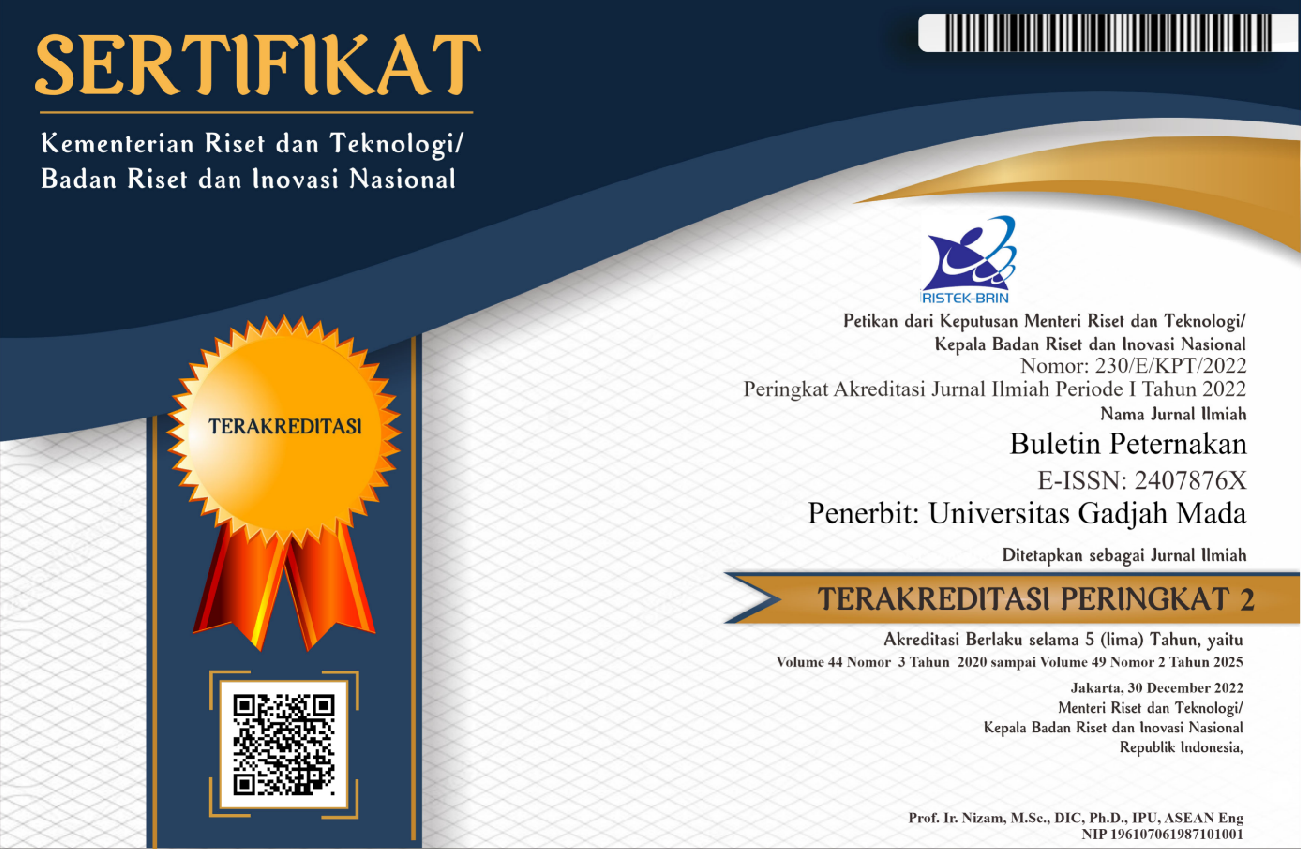Nutrient Quality and in Vitro Digestibility of Bio-Ammoniated Rice Straw Bales
Cuk Tri Noviandi(1*), Dibya Ratnopama(2), Ali Agus(3), Ristianto Utomo(4)
(1) Department of Animal Feed and Sciences, Faculty of Animal Science, Universitas Gadjah Mada, Yogyakarta, 55281, Indonesia
(2) Department of Animal Feed and Sciences, Faculty of Animal Science, Universitas Gadjah Mada, Yogyakarta, 55281, Indonesia
(3) Department of Animal Feed and Sciences, Faculty of Animal Science, Universitas Gadjah Mada, Yogyakarta, 55281, Indonesia
(4) Department of Animal Feed and Sciences, Faculty of Animal Science, Universitas Gadjah Mada, Yogyakarta, 55281, Indonesia
(*) Corresponding Author
Abstract
This study was done to determine the effects of bale sizes of bio-ammoniated rice straw on its nutrient quality and in vitro digestibility. Rice straw were bio-ammoniated by adding 2 g urea and 1 g probiotic/kg DM. By following a completely randomized design, rice straw was baled in 3 different weights (15, 25, and 35 kg) with six replications for each treatment, and then stored for 3 weeks. In the end of the week 3, bales were opened, aired, and then sampled for proximate analysis (dry matter, organic matter, crude protein, and crude fiber) and digestibility by in vitro gas production method. Using analysis of variance method, the proximate data showed that greater the bales size (15, 25, and 35 kg) increased crude protein (7.59, 7.86, and 9.95%, respectively; P<0.05) and decreased crude fiber contents (24.1, 22.1, and 18.8%, respectively; P<0.05). By increasing the size of bales also increased a, b, and c fractions (-0.79, 0.26, and 0.82 mL/100 mg DM; 20.2, 18.2, and 17.6 mL/100 mg DM; 0.012, 0.014, and 0.019 mL/h, respectively; P<0.05) as well as gas production (11.4, 11.5, and 13.8 mL/100 mg DM, respectively; P<0.05). It can be concluded that packing bio-ammoniated rice straw in 35 kg bale is the most effective way in increasing nutrient quality and digestibility of rice straw.
Keywords
Full Text:
PDFReferences
Agus, A., N. Isnaini, and S. Padmowijoto. 2006. Komposisi kimia dan kecernaan in vitro pada jerami padi, jerami padi fermentasi dan silase rumput raja. Buletin Peternakan 30: 1-9.
Agus, A., C. T. Noviandi, and D. I. Rachmawati. 2007. Pengaruh lama peram dan tingkat urea pada fermentasi jerami padi segar terhadap komposisi kimia dan degradasi in sacco. Buletin Peternakan 31: 51-63.
AOAC. 2005. Official Methods of Analysis. 18th edn. Association of Official Analytical Chemist. Gaithersburg, Maryland.
Ball, D., D. Bade, G. Lacefield, N. Martin, and B. Pinkerton. 2015. Minimizing Losses in Hay Storage and Feeding. Mississippi State University. https://extension.msstate.edu/sites/default/files/topic-files/beef-publications/beef-publications-landing-page/minhaylosses.pdf. Accessed: January 21, 2020.
Blümmel, M. and E. R. Ørskov. 1993. Comparison of in vitro gas production and nylon bag degradability of roughages in predicting feed intake dairy cattle. Anim. Feed Sci. Technol. 40: 109-119.
BPS. 2020. Luas Panen, Produksi, dan Produktivitas Padi Menurut Provinsi, 2018-2019. Badan Pusat Statistik. https://www.bps.go.id/dynamictable/2019/ 04/15/1608/luas-panen-roduksi-dan-produktivitas-padi-menurut-provinsi-2018.html. Accessed: 6 April 6, 2020.
Chen, X. B. 1994. Neway Program. International Feed Resources Unit. Rowett Research Institute, Aberdeen, UK.
Davis, R. J. 2016. Hay storage and processing. In: Beef Cattle Feedlots: Design and Construction. P. J. Watts, R. J. Davis, O. B. Keane, M. M. Luttrell, R. W. Tucker, R. Stafford, and S. Janke (eds.). Meat & Livestock Australia Ltd., Australia.
Davies, Z. S., D. Mason, A. E. Brooks, G. W. Griffith, R. J. Merry, and M. K. Theodorou. 1999. An automated system for measuring gas production from forages inoculated with rumen fluid and its use in determining the effect of enzymes on grass silage. Anim. Feed Sci. Technol. 83: 205-221.
Dean, D. B., A. T. Adesogan, N. A. Krueger, and R. C. Littell. 2008. Effects of treatment with ammonia or fibrolytic enzymes on chemical composition and ruminal degradability of hays produced from tropical grasses. Anim. Feed Sci. Technol. 145: 68-83.
Gomez, K. A. and A. A. Gomez. 1984. Statistical Procedures for Agricultural Research. 2nd edn. An International Rice Research Institute Book. John Wiley and Sons, Inc. New York.
Hartadi, H., S. Reksohadiprodjo, and A. D. Tillman. 2005. Tabel Komposisi Pakan untuk Indonesia. 3rd edn. Gadjah Mada University Press, Yogyakarta.
Menke, K. H. and H. Steingass.1988. Estimation of the energetic feed value obtained from chemical analysis and in vitro gas production using rumen fluid. Ann. Res. Dev. 28: 7-55.
Putun, A. E., E. Apaydin, and E. Putun. 2004. Rice straw as a bio-oil source via pyrolysis and steam pyrolysis. Energy Int. J. 29: 2171- 2180.
Sarnklong, C., J. W. Cone, W. Pellikaan, and W. H. Hendriks. 2010. Utilization of rice straw and different treatments to improve its feed value for ruminants: A review. Asian-Aust. J. Anim. Sci. 23: 680-692.
Sarwono, B. and H. B. Arianto. 2003. Penggemukan Sapi Potong Secara Cepat. Penebar Swadaya, Jakarta.
Van Soest, P. J. 2006. Review: Rice straw, the role of silica and treatments to improve quality. Anim. Feed Sci. Technol. 130: 137-171.
Yang, H. E., Y. S. Son, and K. A. Beauchemin. 2011. Effects of exogenous enzymes on ruminal fermentation and degradability of alfalfa hay and rice straw. Asian-Aust. J. Anim. Sci. 24: 56-64.
Article Metrics
Refbacks
- There are currently no refbacks.

This work is licensed under a Creative Commons Attribution-ShareAlike 4.0 International License.
Buletin Peternakan (Bulletin of Animal Science) Indexed by:

This work is licensed under a Creative Commons Attribution-ShareAlike 4.0 International License.









